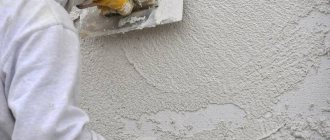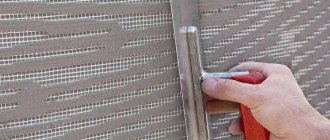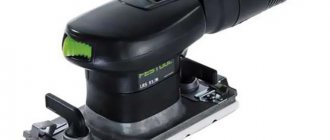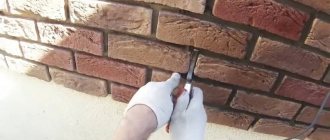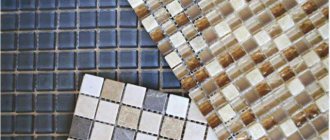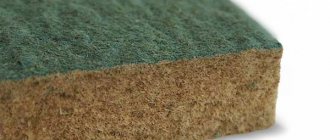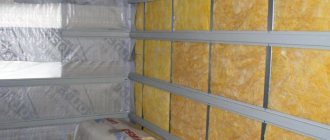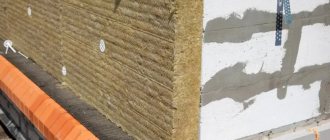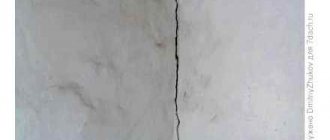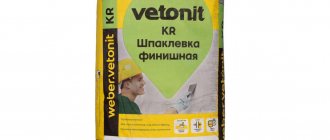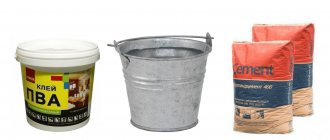What does elastic putty consist of?
Elastic putty consists of a number of components. These are mainly polymer resins and fiberglass. Acrylic elastic putty retains all the properties of standard putty. The difference is increased adhesive abilities. The elasticity of this material practically eliminates shrinkage of the material and the formation of cracks. On the market you can see elastic putty based on silicone. A different composition from the previous one allows you to create a grainy surface. The first option makes the surface smooth.
The elastic putty is white with a milky tint. The consistency is viscous and resembles a paste. For some manufacturers, the color of elastic putty may be gray.
Compound
Manufacturers add the following components to the silicone mixture:
- liquid potassium glass;
- silicone resins;
- marble chips;
- titanium dioxide.
Acrylic putty is made on the basis of:
- water;
- acrylates;
- plasticizers;
- modifiers.
Preparing to work with elastic putty
To work you will need:
- Elastic putty. The quantity is calculated by surface area;
- Tools for work. Spatula, trowel, trowel, reinforcing mesh;
- Prepared work surface. The wall must be cleaned of dust and dirt. If they have deep revivals, they must be eliminated. For better adhesion, a primer is applied.
How to work with elastic putty
Elastic putty is sold ready-made. It is applied with specialized tools. If elastic putty is used in hard-to-reach places or corners, use reinforcing mesh. When applying, a certain temperature must be maintained. From 4 to 32 degrees Celsius.
If something doesn’t work out for you, you can wash off the putty layer with water. This should be done until it dries. After drying, the surface can also be adjusted. Dried putty can be sanded. This way you will get rid of roughness and excess.
What kind of material is this
Elastic putty is a synthetic mixture that contains a polymer resin and various types of fillers.
- strength;
- durability;
- protection against mold and mildew;
- does not crack;
- provides the best performance characteristics.
- ready-made mixtures;
- dry powdery.
Types of elastic putties
There are special compositions for finishing wooden surfaces on sale. The product can be applied to furniture, frames, parquet floors, door frames and other types of structures.
Working with material
Before starting application, prepare the necessary tools and materials.
Preparing for work
An important stage of finishing is preparing the surface: remove dust, dirt, and thoroughly dry the wall. This will ensure a strong connection of the new layer with the base and reduce the risk of cracks.
After this, they begin priming the surface. The mixture creates a transparent and vapor-permeable coating, increases adhesion and ensures proper drying of the new layer. The primer contains resins that bind the loose elements of the base and strengthen its structure.
After the primer has dried, begin applying elastic putty.
How to work with putty
The finished mixture can be applied to the wall or ceiling immediately after opening the package. Powdered putty is mixed with water, following the manufacturer's instructions. Most often, about 0.35 liters of water are consumed per 1 kg of substance.
After combining the ingredients and obtaining the required consistency, wait a few minutes (the mixture is used within an hour). Immediately before application, the mass is mixed again. The elastic material can be applied by hand or by machine.
Putty for sealing cracks
After preparing the solution, finishing begins. Apply a layer 2 mm thick. The room temperature should not be lower than +5°C and not higher than +30°C. The drying time of the putty depends on air humidity, type of composition and other factors. Further work is carried out approximately 48 hours after applying the mixture.
Main types of putty.
The choice of putty depends on the task at hand. It should be noted that putty is divided into two types: dry and ready-to-use. The composition of high-quality dry putty is complex and multi-component. To use it, it is necessary to dilute the mixture with a certain amount of clean water.
When making high-quality dry putty, the basis is gypsum or cement, necessarily modified with polymers, which provides good water resistance, elasticity, ease of processing, good adhesion of the material to the base, and increased durability of the material. Gypsum putty differs from others in its whiteness, high plasticity, ease of application and ease of sanding, but it is used only in dry rooms.
If the humidity in the room exceeds the norm, then you should use cement-based putty, it has the property of increased moisture resistance. It should also be taken into account that cement putties must be sanded after 1-2 days, since they tend to gain strength over time and after a month you are unlikely to be able to sand it.
Cost of putty
Other formulations
Putty for walls Stuc-O-Flex (16 thousand rubles / 19 l) is intended for leveling surfaces and sealing joints and cracks. Suitable for indoor and outdoor use. Advantages of the product: the mixture is easy to work with, adheres well to rough and porous surfaces (even without the use of a primer), and forms a smooth surface. The putty can be applied to gypsum, concrete, brick, plasterboard, cement, wood and other coatings.
Presto putty (RUB 2500-2800/12 l) is a two-component mixture of polyester resins and various minerals. Suitable for repairing small and medium cracks and various deformations. The product can be applied to plastic, wood, metal and concrete surfaces.
- elastic;
- soft;
- pasty;
- forms an even layer;
- easy to sand;
- dries quickly;
- has good adhesion.
- density: 1.89 g/dm³;
- heat resistance: 120°C.
To prepare the solution, 2-4% hardener is required.
Source
How to use putty materials
Let's consider the main areas of application of this material. This is the elimination of defects on a wooden floor, sealing various kinds of cracks, imitation of wood texture on the surface.
Putty for wooden floors
Putty for wooden floors must contain components that will prevent the material from quickly wearing out from mechanical stress.
If you try to save money, then after 2-3 years the sealed surface will deteriorate and crack
Aqueous, paste-like and gel-like compositions are suitable for the floor. If the product contains fiber fiber, then the durability of the finished coating is guaranteed.
Nitro-based putty will also be stable. In the composition you need to look for cellulose ether components, acetone, resins. Products containing wood flour have a high level of adhesion to any type of wood. Nitro putties, for all their positive qualities, have a rather pungent odor.
Homemade compounds mixed with wood flour ideally fill cracks and seams on wooden floors
Wood putty: what to use to fill cracks
A small gap in a wooden floor is sealed either with a putty of a suitable color, or with a composition of any shade, followed by priming and painting the floor.
Cracks 3-4 mm in size are sealed with acrylic products; larger defects should not be touched, as the finished material will crumble and fall out.
The solvent-based product is well suited for sealing cracks up to 1 cm, and can even eliminate defects on heated floors.
Oil compositions for eliminating narrow cracks should be mixed with chalk, and for wide flaws - with wood dust.
Imitation of wood from putty as a way to decorate the surface
To make imitation wood, a number of tools are required. You need to get a palette knife, a textured roller, a roller with a picture of a wood cut, several types of rubber spatula, and a stencil.
Acrylic, gypsum and silicone bases are suitable for interior finishing.
Beautiful imitation wood made of putty
Elastic putty for seams
Elastic putty is a composition created specifically for work when preparing internal surfaces for applying the finishing coating.
It is indispensable when repairing foundations that are characterized by mobility and the ability to deform. The main condition for performing quality work is not to use this composition as a leveling mixture on the outside of the building. This type of putty is widely used when filling joints between two different materials. For example, it can be used to fill seams and joints between metal and concrete, wood and brick.
Features of the composition
Elastic putty is used as a material that allows not only to efficiently hide joints between surfaces with different properties, but also to ensure a high level of strength of the top layer of coating.
After the composition hardens, a durable film is formed on its surface, and the inner layer retains its elasticity, withstanding the loads that arise when the structure deforms.
When constructing a thermal insulation layer, many craftsmen install polystyrene foam boards, and fill the seams between them with polyurethane foam. In most cases, puttying must be done before finishing.
The joints of polystyrene foam boards can be properly and reliably closed using elastic putty.
Modern manufacturers produce two types of such compositions, which differ from each other in their basis. A polymer is used as a base, on which the quality of the resulting surface depends.
Acrylic elastic putties are used to create a flat and absolutely smooth surface in preparation for painting or wallpapering.
Silicone - allows you to create a grainy, rough surface suitable for laying tiles.
Features of elastic putty:
- applied to all types of substrates;
- used when filling joints of various materials;
- has high elasticity.
It does not flow off the spatula and easily lays on the wall, providing a high level of moisture and vapor permeability. Most often, this material is used when working on wooden, concrete, and metal coatings, since it is in such conditions that elastic putty shows all its best qualities.
When choosing one or another composition, you should carefully study the recommendations and instructions for use. This is due to the fact that some products can be used at a certain temperature and humidity.
Universal formulations
Products that can be used both indoors and outdoors are less common. Typically, this quality characterizes plasters for concrete and brick. But in the case of wood, you can find worthy analogues. When choosing such compositions, you should pay attention to the presence of a water-repellent effect, high adhesion and strength. Universal putty for wood can be either oil-based or water-based - the main thing is that it does not crumble and is flexible. Another important quality of such solutions is the anti-frost effect, which prevents the coating from cracking in extreme cold conditions.
Preparation and execution of work
Careful surface preparation is carried out regardless of what kind of mixture will be applied. First of all, you need to remove all contaminants and get rid of dust. Of great importance in preparation is the high-quality filling of all detected cracks and cracks.
The deepest ones can be filled with polyurethane foam or cement-sand mixture. After hardening, excess foam is cut off with a stationery knife and priming begins.
When choosing a primer, it is necessary to pay attention to compositions that have a high level of penetrating ability and contain antiseptic substances. This will reliably protect the treated surface from mold and mildew.
The primer is applied in two layers. The drying time of the first one is from 2 to 4 hours; you can start puttying 12 hours after the formation of a thin and durable film.
On such a surface, the elastic putty is distributed evenly and laid down in a thin layer. This will not only enhance the adhesion of the putty to the surface, but also reduce material consumption, avoiding unnecessary material costs.
To perform the work, either a ready-made solution or a dry mixture can be selected. In any case, the composition should be thoroughly mixed before starting manipulations. Do not neglect this advice. Refusal of additional mixing will cause the loss of some qualities and main properties of the mixture.
DIY metal putty
Before you start puttingtying a metal surface with your own hands, you need to decide on the type of mixture that will be suitable in this case. However, among the variety of putty materials for metal, the most popular is a mixture with an epoxy composition.
After acquiring the necessary material, a step-by-step process occurs:
- The first step is to prepare the coating well, remove rust and dirt, degrease and prime it. If you use an epoxy mixture, you can do without a primer.
- A certain amount of putty that will be needed for the job must be mixed with a hardener. After thoroughly mixing the base until smooth, you can begin puttying.
- Using a thin spatula, apply the mixture to scratches, dents or existing holes in the metal. The excess is carefully removed with the same spatula so that there are no flaws.
- When the putty solution hardens on the surface, it must be sanded with sandpaper soaked in water. The result is a smooth and even surface, ready for powder painting in the desired color.
The putty on the rear fender is cracked (3 centimeter crack), how to solve this problem? Why not paint the whole side? and how to remove dog nail scratches from your bumper.
You open the crack, pick out everything you can. If the thickness of the putty is more than 1 mm, use tin. This is the right thing to do. Otherwise, it’s a matter of choice. Plasticine, spray can, etc.
If the thickness of the putty is more than 1 mm, use tin. This is what I didn't understand
Features of the work
To prepare a high-quality solution from a dry mixture, you will need to strictly follow the manufacturer’s recommendations and the proportions specified in the instructions on the package.
First, cold water is poured into the container, and the dry composition is introduced into it in small portions. To obtain a solution, mix the components using a construction mixer or drill equipped with a special attachment. Its blades are installed so that during the mixing process the solution rises from bottom to top.
After the first mixing, the composition should sit for 10-15 minutes, the mixer is again immersed in the container and the steps are repeated. Again, the composition is allowed to sit for at least 15 minutes and only after that they begin to work. For more information on how to putty walls, watch this video:
Application to the surface is carried out using a small spatula to apply the composition to the main tool, which is either a large spatula or a trowel (trowel, malka).
The composition is distributed over the surface from the far corner, from bottom to top. If one person is working and covering the bottom half of the wall first, sand the edge to eliminate any noticeable transition before starting to putty the top half.
Complete drying will occur no earlier than after three days. After this, the surface is treated with sandpaper, if necessary, and painting begins.
Source
Useful tips
- When treating fences, walls of houses and other buildings, as well as outbuildings made of wood, it is best to give preference to oil-based compounds. Moreover, they can be used after the wood has been impregnated with compounds against rotting and insects, but before painting;
- Treating parquet and other wooden surfaces that we often come into contact with is best done with safe water-based compounds. Yes, they take longer to dry, but their price is more affordable;
- Regardless of the surface, acrylic options are the most attractive. They can be successfully used both indoors and outdoors. It must be remembered that the composition of such putties is white, and therefore it is necessary to apply paint over them, otherwise the place will stand out strongly.
If the composition needs to be diluted, then this should be done until it becomes sour cream. The work is best done with a drill with a special attachment. It should be remembered that the composition dries quickly, so mixing large quantities of putty at once is not recommended.
vote
Article rating
